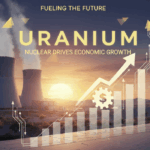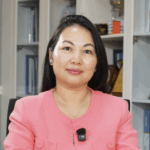“E-S-Linky,” replied Enkhbold when I asked what the name of his dog was. A Korean artist and friend of Enkhbold’s would not let go of a puppy found in the Mongolian countryside during a field trip for conceptual artists a few years ago. So, thinking of his own lost dog, Enkhbold offered to keep the furry fellow. The artist’s son, Enkhmanlai gave him the name.
E-Slinky is a young dog with a shiny black, medium-length coat. His ears are upright and stylishly flopped at the tips. Alert and curious woofs resounded in the Mongolian January air as we stepped in to Enkhbold’s yard. The dog is tethered to his post and is wagging his curled, bushy tail. E-Slinky inquisitively assesses my palm. He approves, I think.
E-Slinky is positively cool in a postmodern way: even in the presence of his trusted owner, he is skeptical of the reasonable inferences. He remains vigilant as Enkhbold shows me frozen camel hides scattered throughout the yard. They had been soaking in a copper-colored dye made from the soil of his native land in Uvur-Khangai province.
The artist generously produced several pieces like these from the treasury of his yard, as if he were a child proudly showing off his toys to a guest. We look. What appears to be a chaotic assortment of random debris to E-Slinky and me, is a creative goldmine to Enkhbold. He sees the miraculous in that which practical vision cannot fathom.
Mining 2024 is the fifth in the series of solo exhibitions by Enkhbold. The first one was showcased about a decade ago. The artist presents each show with a three-to-four-year break in between. The central theme revolves around preservation of the natural environment and nomadic heritage, which are the traditional sources of Mongolian people’s cultural values. The postmodern aspect in Enkhbold’s art comes into play through the artist’s self-awareness of his role as a creator in a developing country, and a partaker of society in constant flux.
The dyed camel hides mounted to approximately three-meter-tall metal panels comprise an eight-piece installation. Its title could be translated as “The Stranded in a Desolate Land.” The Mongolian title literally means “… without an Owner in an Empty Steppe.” Duldegsed is a word invented by Enkhbold. It evokes other words in Mongolian such as left, abandoned, heaving, deaf, vagabonding.
The malleability of the camel skins affixed to the unbending industrial waste seem to highlight the fragility of nature by contrast to man’s unrelenting quest for advancement and the insoluble footprints he leaves on the way toward progress. The artist’s concern for the environment seems to seep through the warmth of a red-orange hue in the organic matter, clashing with the sharp grey from the man-made silver backboards.

The focal part of the installation consists of a forward tilted ladder leading to a satellite dish. “I imagine it to be a mirror,” explained Enkhbold. The conspicuous point of reference reflects the uncertainty of the aims in seemingly rational human endeavors.
On the far right of the installation, there is a vertical roll of rawhide wrapped in rusted bands of saw blades. They resonate with the wires that protrude from the camel hides throughout the rest of the artwork. The resulting effect brings to mind a violent wounding. The marks that the rusted wires and ribbons leave by threading, wrapping, and stabbing through the once living membranes, suggest a manual force preventing the natural decomposition of organic matter. The intertwined yet contrasting mediums create layers that are separated from each other with bolts and hooks. The viewer is able to walk and weave through the eight panels. The shadows from the detached layers of raw materials enhance the interactive experience and the intensity of “The Stranded in a Desolate Land.”
Raising spatial awareness in the audience is a byproduct of exhibiting installation art. A sense of space is a significant leitmotif in Enkhbold’s artworks, including his installations, performances, paintings, conceptual pieces and creative experiments.

The visual poetry expressed in Enkhbold’s abstract paintings is particularly captivating. He paints with pigments made from organic and inorganic elements such as soil, soot, livestock dung, rust, and dried herbage. Often embossed with hoof prints, brands, film from animal organs or remnants from historic objects, the paintings emit an ancient spirit and the nourishing warmth of the earth. The visual topography of the monochromatic tones enchants the eyes, as if the rustic patterns in relief were recounting stories of nomadic ancestors from a time when man and nature lived in peace and harmony with one another. The veneration of nature being a crucial aspect of traditional nomadic upbringing, a gesture of benevolence toward living and non-living forms of nature, is visually palpable in the artist’s abstractions. The spatial harmony of an earthy consistency in the compositions of his paintings have almost a grounding effect that restores energy and reinstates natural balance to the vision.

In 2009, Enkhbold partook in an artistic residency exhibition in Rotterdam, Netherlands pioneered by Finnish curator Annu Wilenius. In a truly nomadic manner, the conceptual artist packed up one small gher and took off onward to his first substantial creative mission abroad. For three months, Enkhbold devoted himself to conceptual art experiments and public performances with his gher in a foreign land for people whose language he did not speak. The experience made an indelible impression on the artist and has remained an ember of inspiration in his creative practice ever since. “The sea and its people had a beautiful energy in a different way when I was creating my performances,” reminisced Enkhbold.
The concept and sensation of space, whether geographical, physical, cultural or relational, seem to become fluid depending on the environment the artist works in. The traditional Mongolian nomadic understanding of space and its unlimited expanse seem to create a contradictory perception when expressed in urban settlements where the concept of privacy, property, order and practice take precedence. Enkhbold’s performances speak to these paradoxical conditions of human existence. In a way, the performances are also an act of homage to nature and to the hearth of a Mongolian traditional home.
Enkhbold and his wife, artist L. Munguntsetseg have three young children. He told me, “As a father, I worry about the environment that my children will inherit when they grow up. The purpose of my art also includes raising awareness of the preciousness and fragility of nature. I think that it is the only real source of nourishment for the human body and soul. Through my exhibition I want to show that the connection between man and nature must not be severed but cultivated with care.”

The rapid change in Mongolian society brought by the mining boom and consumerism raises many important questions. As man himself is a part of nature and has the power to both create and destroy, the meaning of mining in Enkhbold’s exhibition introduces a unique perspective on the concept of extraction. As we ponder for a moment the question of how to preserve traditional nomadic wisdom and mindfully handle soil and land so as to continue a harmonious exchange between man and nature, the notion of progress that we so eagerly strive for might become meaningless if the natural source including humanity will be irreparably damaged in the process. This question seems to be one thread that connects E-Slinky, the “mirror” and me.
Mining 2024 is on display until February 4th in B Contemporary Art Gallery.
(Cover Photo: artist T. Enkhbold, on the right, during exhibition opening night, featured B. Bat-Orshikh, throat singer and leader of Domog)
By J. Ariunaa
Published in UB Post
January 24, 2024








